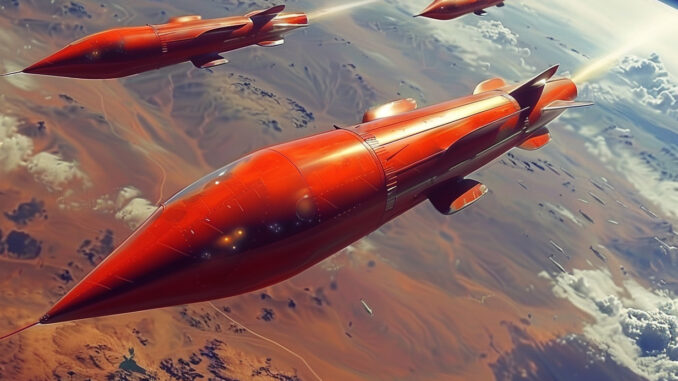
Analysis of the Pentagon’s need for long-range hypersonic drones to overcome the geographical and technological challenges of the Pacific theatre.
The Pentagon is considering swarms of short-range autonomous drones to dominate the battlefield. However, in the Pacific, where distances are vast and enemy capabilities advanced, this strategy presents vulnerabilities. Long-range hypersonic drones would be better suited to guarantee lasting military superiority. These systems could overcome logistical and electronic warfare challenges, ensuring better preparedness for threats in this strategic region.
The Pentagon’s need for swarms of long-range hypersonic drones
The limitations of short-range UAVs
The Pentagon is proposing a strategy based on swarms of short-range autonomous drones, with a range of less than 100 kilometres. This approach may be effective in Europe, where distances are shorter and the terrain offers opportunities for concealment. However, in the Pacific, this strategy has significant limitations. The islands in this region stretch for thousands of kilometres and the adversary has advanced anti-access/area denial (A2/AD) capabilities. The limited range of UAVs is a critical vulnerability in such an environment.
Logistical challenges in the Pacific
Deploying and maintaining swarms of UAVs across the vast expanses of the Pacific requires a robust network of forward operating bases. These bases must provide logistics, maintenance and C4ISR (Command, Control, Communications, Computers, Intelligence, Surveillance and Reconnaissance) support. Establishing such a network in a region where access is highly contested is a daunting task. UAVs could be exposed to enemy attacks while still on the ground, making their deployment risky and potentially ineffective.

Communications and electronic warfare vulnerabilities
Even swarms of fully autonomous drones require reliable communications and data links for battle damage assessment and mission reassignment. In the vastness of the Pacific, signal jamming and disruption of these links become powerful tools for the adversary. An autonomous swarm dependent on short-range communications could be vulnerable to electronic warfare, reducing the effectiveness of its AI capabilities and making it susceptible to counter-attacks.
Advantages of long-range hypersonic drones
Rather than pursuing a strategy based on short-range swarms, the US should concentrate on developing long-range hypersonic autonomous drones. These systems, derived from hypersonic VTOL (Vertical Take-Off and Landing) technologies being developed in the private sector, would be much less vulnerable to attack, both on the ground and in the air. Investment in autonomous hypersonic VTOL platforms with extended ranges would make it possible to deliver low-cost hypersonic precision munitions over much greater distances than currently envisaged.
Resilience and advanced capabilities
Reusable hypersonic platforms would operate at high speeds and altitudes, increasing their survivability. They would also facilitate the creation of an advanced network of sensors and communications in “near space”, capable of overcoming the challenges posed by the vast distances of the Pacific and complex electronic warfare environments. These hypersonic UAVs would provide increased resilience to adversary disruption and ensure effective communication and coordination, essential for successful military operations in this region.
Strategic implications and need for investment
The Pacific theatre requires a strategic approach that overcomes the unique challenges of geography and the evolution of warfare. The United States must invest in technologies and capabilities that ensure a decisive long-term advantage. Failure to do so risks leaving the US ill-prepared for the realities of the Pacific theatre, where the distance between ambition and reality can be immense. Investment in long-range hypersonic drones and associated support infrastructure is essential to maintaining US military superiority in this region.
To ensure adequate preparedness for the challenges of the Pacific theatre, the Pentagon needs to reassess its current strategy and turn to more appropriate technologies. Long-range hypersonic drones offer a viable solution to overcome the limitations of short-range systems. They enable an effective response to threats while ensuring resilience and operational effectiveness. By investing in these technologies, the United States can maintain its military superiority and meet the strategic requirements of this crucial region.
War Wings Daily is an independant magazine.